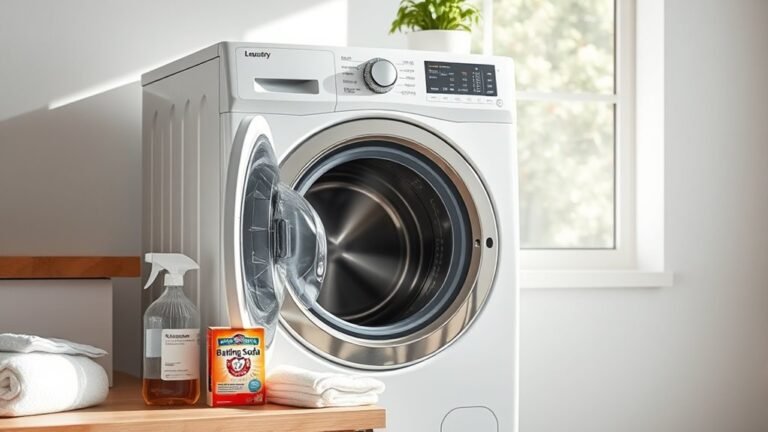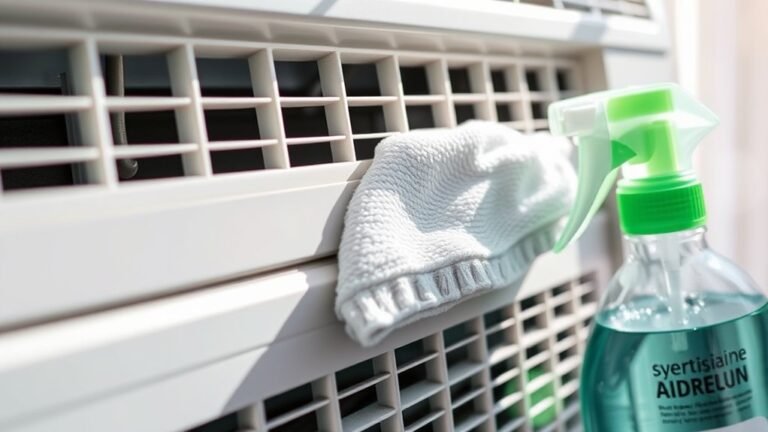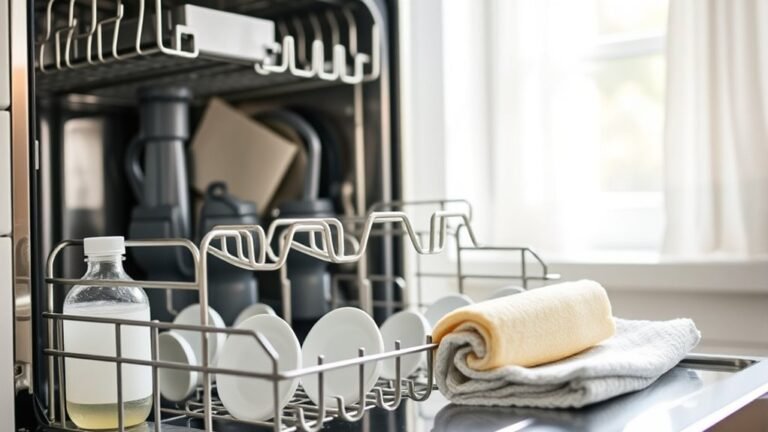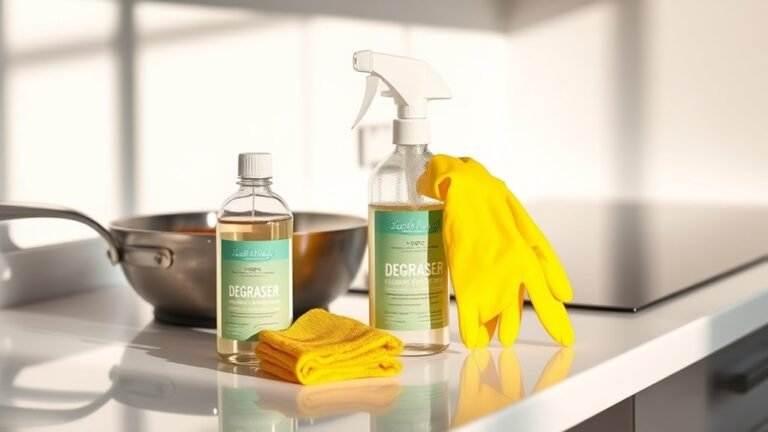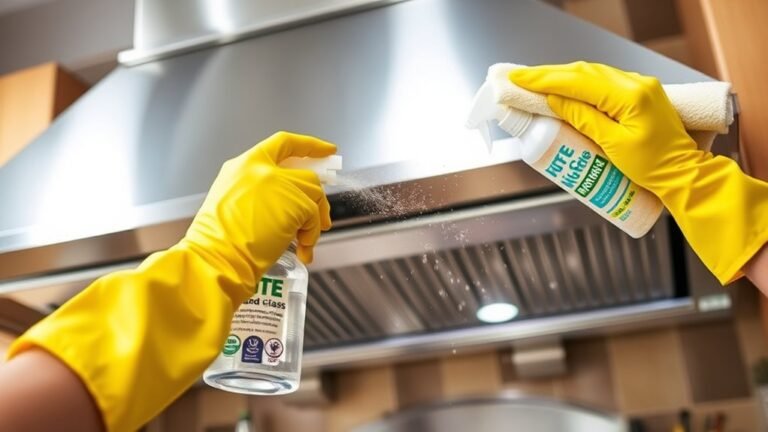Cleaning and Maintaining Your Humidifier
To keep your humidifier working well and your air healthy, clean it regularly by emptying and rinsing the tank daily to prevent mold. Once a week, soak parts in a vinegar solution, scrub gently, rinse thoroughly, and let them dry completely. Use distilled water to reduce mineral buildup, and place the humidifier on a level surface to avoid leaks. Proper care extends its life and guarantees clean mist—there’s more to know about tackling common issues and storing it right.
Understanding Different Types of Humidifiers

Before you start cleaning, it’s important to understand the different types of humidifiers you might have. You’ll typically come across two main kinds: cool mist and warm mist. Cool mist humidifiers release a revitalizing, room-temperature vapor, making them ideal if you want to keep your space comfortable without added heat. Warm mist humidifiers, on the other hand, boil water to produce a gentle, warm vapor, which can also help soothe respiratory issues. Knowing which one you own helps you choose the right cleaning method and products, ensuring your device works efficiently and safely. By understanding these types, you take control over your environment and maintain the freedom to breathe easy without worrying about harmful buildup or inefficiency in your humidifier.
Importance of Regular Cleaning
Knowing the type of humidifier you have is just the beginning—keeping it clean is what truly guarantees it works well. Regular cleaning prevents mineral buildup and bacteria growth, ensuring your device delivers pure, healthy moisture. By sticking to a proper cleaning frequency, you maintain peak humidifier hygiene and avoid potential health risks like mold spores or allergens spreading in your space. Neglecting this routine can limit your humidifier’s effectiveness and shorten its lifespan, restricting your freedom from dry air discomfort. Taking control of your humidifier’s cleanliness not only protects your health but also empowers you to enjoy the full benefits of comfortable, breathable air without worry. Make cleaning a non-negotiable habit, and your humidifier will keep serving you reliably and safely.
Daily Maintenance Tips
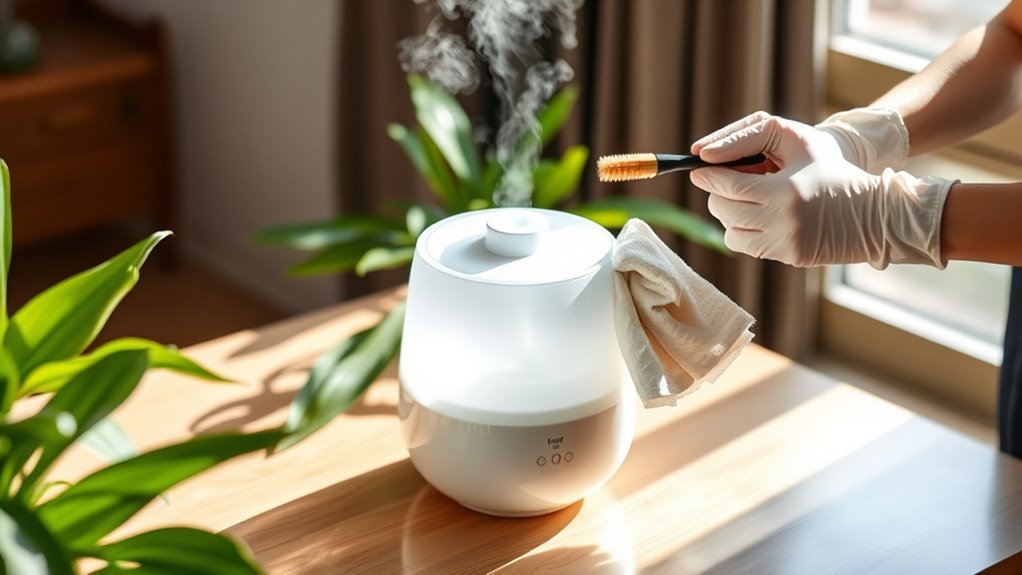
Even if you clean your humidifier thoroughly on a weekly basis, daily maintenance is key to keeping it running smoothly. Start your daily checklist by emptying any leftover water to prevent mold and bacteria growth. Rinse the water tank with fresh water and dry it before refilling. Check the humidity levels in your space and adjust the humidifier settings accordingly to maintain ideal comfort without over-humidifying. Inspect the device for any visible buildup or damage, and wipe down external surfaces to keep dust at bay. By sticking to this simple daily routine, you guarantee your humidifier operates efficiently, prolonging its lifespan and keeping your environment healthy. This small commitment gives you the freedom to enjoy clean, balanced air every day.
Weekly Deep Cleaning Process
Since daily maintenance only handles surface-level care, you’ll need to perform a weekly deep cleaning to thoroughly remove mineral deposits, mold, and bacteria buildup. Start by unplugging your humidifier and disassembling the removable parts. Use a recommended cleaning solution or a mixture of water and white vinegar to soak the components for about 30 minutes. This step loosens stubborn grime and kills germs, freeing you from potential health risks. After soaking, gently scrub with a soft brush to remove any remaining residue. Rinse all parts thoroughly with clean water to avoid leaving any cleaning solution behind. Allow everything to air dry completely before reassembling. By committing to this deep cleaning routine, you maintain your humidifier’s efficiency and enjoy fresh, healthy air without restrictions.
Removing Mineral Deposits and Scale

One of the most common issues you’ll face with your humidifier is mineral deposits and scale buildup, especially if you use hard water. These deposits can clog your device and reduce its efficiency. For effective mineral removal, follow these steps:
- Fill the tank with a mixture of equal parts white vinegar and water. Let it soak for 30 minutes to break down scale buildup.
- Use a soft brush or cloth to scrub away loosened deposits gently.
- Rinse thoroughly with clean water to remove vinegar residue.
Regularly tackling mineral removal not only frees your humidifier from stubborn scale but also helps maintain peak performance. This simple routine guarantees your device works smoothly, giving you the freedom to enjoy clean, humidified air without hassle.
Preventing Mold and Bacteria Growth
Although regular cleaning removes mineral deposits, preventing mold and bacteria buildup requires extra attention. To keep your humidifier fresh and safe, you need to focus on mold prevention and bacteria control daily. Always empty leftover water after use—stagnant water invites harmful growth. Use distilled or filtered water to reduce impurities that feed bacteria. Clean your humidifier thoroughly at least once a week with a vinegar solution or manufacturer-recommended cleaner to eliminate hidden mold. Make sure all parts dry completely before reassembling to discourage mold growth. By staying consistent with these simple habits, you’ll enjoy the freedom of clean, healthy air without worrying about harmful bacteria or mold taking over your humidifier. Your well-being depends on it.
Proper Storage During Off-Season
Keeping your humidifier clean and dry after each use helps prevent mold and bacteria, but it’s equally important to think about how you store it when you’re not using it. Proper seasonal storage guarantees your humidifier stays in great shape and ready for action when humidity levels drop again. Here’s what you should do:
- Disassemble all parts and thoroughly dry them to avoid moisture buildup.
- Store the humidifier in a cool, dry place away from direct sunlight and extreme temperatures.
- Keep it in a sealed container or plastic bag to protect it from dust and pests.
Troubleshooting Common Humidifier Issues
If your humidifier isn’t producing enough moisture, making strange noises, or leaking water, it’s time to troubleshoot. You’ll want to check for common causes like clogged filters, loose parts, or overfilled tanks. Fixing these issues quickly helps keep your humidifier running smoothly and your air comfortable.
Identifying Moisture Problems
How do you know when your humidifier isn’t working right? The key lies in checking your room’s humidity levels and spotting any moisture issues early. You want to keep moisture measurement consistent to avoid problems like mold or stagnant air. Here’s how you can identify moisture problems:
- Inconsistent humidity levels: If your hygrometer shows fluctuating readings, your humidifier might be malfunctioning or set incorrectly.
- Condensation build-up: Visible water droplets on windows or walls indicate excess moisture, meaning your humidifier’s output is too high.
- Dry air persists: If you still feel dry despite running the humidifier, it’s likely not producing enough moisture.
Tackling Unusual Noises
Although humidifiers are designed to run quietly, you might notice unusual noises that signal a problem. Common noise sources include loose parts, mineral buildup, or a misaligned fan. First, check if the water tank is seated properly—improper placement often causes rattling. Next, inspect for mineral deposits on the ultrasonic plate or fan blades; these can create buzzing or grinding sounds. Regular cleaning can prevent buildup and reduce noise. If you hear a humming or vibrating sound, tightening screws or repositioning the humidifier on a level surface often provides sound solutions. Addressing these issues promptly frees you from annoying distractions and guarantees your humidifier runs smoothly, letting you enjoy the comfort and freedom of clean, moist air without interruption.
Resolving Water Leakage
Unusual noises often point to underlying issues, but water leakage is another common problem that can disrupt your humidifier’s performance. When you notice water pooling around your device, start by checking the water source. Make sure the tank is securely seated and free from cracks. Also, consider these key steps:
- Inspect the seals and gaskets for damage that might let water escape.
- Verify the unit is on a level surface to prevent uneven water flow.
- Adjust the humidity levels appropriately; too high can cause condensation and leaks.
Frequently Asked Questions
Can I Use Essential Oils in My Humidifier Safely?
If you want to use essential oils in your humidifier, you need to be careful about humidifier safety. Not all humidifiers are designed for essential oils, and using them incorrectly can damage the device or affect air quality. To keep your freedom to enjoy scents safely, check if your humidifier supports essential oils or consider a diffuser made for them. This way, you can enjoy aromatherapy without worrying about your humidifier’s health or safety.
How Does Humidity Affect My Home’s Energy Efficiency?
Did you know maintaining ideal humidity levels can reduce your heating costs by up to 20%? When you keep your home’s humidity balanced, the air feels warmer, so you don’t have to crank up the heat as much. This means you save energy and money without sacrificing comfort. Controlling humidity levels lets you enjoy energy savings while staying free from high utility bills—giving you more freedom to spend on the things you love.
Are There Health Risks From Overusing a Humidifier?
Yes, you can face health risks from overusing a humidifier. When humidity levels get too high, it creates a breeding ground for mold and dust mites, which can harm your respiratory health. You might experience congestion, coughing, or irritation. To enjoy the freedom of a comfy home, keep humidity balanced—ideally between 30-50%—so you protect your lungs without feeling trapped by dryness or excess moisture.
What Type of Water Is Best for Humidifiers?
When it comes to choosing water for your humidifier, think of distilled water as the purest companion, free from minerals and impurities that could otherwise leave behind unwelcome residues. While tap water is readily available, it carries minerals that might invite unwanted buildups in your device. By selecting distilled water, you’re embracing a cleaner, more liberated experience, ensuring your humidifier works efficiently without the constraints of mineral deposits.
Can Humidifiers Help With Allergies or Asthma Symptoms?
Yes, humidifiers can support your allergy relief and asthma management by adding moisture to dry air, which often worsens symptoms. When the air’s properly humidified, it can soothe irritated nasal passages and airways, making it easier for you to breathe freely. Just remember, keeping humidity levels balanced is key—too much moisture might encourage mold or dust mites, which could trigger symptoms instead of easing them.

